Enhance of Sensitivity of Corrole Functionalized Polymeric Microspheres Coated Quartz Microbalances †
Abstract
:1. Introduction
2. Experimental
3. Results and Discussion
Conflicts of Interest
References
- Paolesse, R.; Nardis, S.; Monti, D.; Stefanelli, M.; Di Natale, C. Porphyrinoids for chemical sensor application. Chem. Rev. 2017, 117, 2517–2583. [Google Scholar] [CrossRef] [PubMed]
- Di Natale, C.; Paolesse, R.; Martinelli, E.; Capuano, R. Solid state gas sensors for breath analysis: A review. Anal. Chim. Acta 2014, 824, 1–17. [Google Scholar] [CrossRef] [PubMed]
- Filippini, D.; Alimelli, A.; Di Natale, C.; Paolesse, R.; D’Amico, A.; Lundström, I. Chemical sensing with familiar devices. Angew. Chem. Int. Ed. 2006, 45, 3800–3803. [Google Scholar] [CrossRef] [PubMed]
- Di Natale, C.; Paolesse, R.; Macagnano, A.; Nardis, S.; Martinelli, E.; Dalcanale, E.; Costa, M.; D’Amico, A. Sensitivity-selectivity balance in mass sensors: the case of metalloporphyrins. J. Mater. Chem. 2004, 14, 1281–1287. [Google Scholar] [CrossRef]
- Aviv, I.; Gross, Z. Corrole-based applications. Chem. Commun. 2007, 20, 1987–1999. [Google Scholar] [CrossRef] [PubMed]
- Capuano, R.; Pomarico, G.; Paolesse, R.; Di Natale, C. Corroles-porphyrins: A teamwork for gas sensor arrays. Sensors 2015, 15, 8121–8130. [Google Scholar] [CrossRef] [PubMed]




Publisher’s Note: MDPI stays neutral with regard to jurisdictional claims in published maps and institutional affiliations. |
© 2017 by the authors. Licensee MDPI, Basel, Switzerland. This article is an open access article distributed under the terms and conditions of the Creative Commons Attribution (CC BY) license (https://creativecommons.org/licenses/by/4.0/).
Share and Cite
Savoldelli, A.; Magna, G.; Nardis, S.; Fronczek, F.R.; Smith, K.M.; Natale, C.D.; Paolesse, R. Enhance of Sensitivity of Corrole Functionalized Polymeric Microspheres Coated Quartz Microbalances. Proceedings 2017, 1, 406. https://doi.org/10.3390/proceedings1040406
Savoldelli A, Magna G, Nardis S, Fronczek FR, Smith KM, Natale CD, Paolesse R. Enhance of Sensitivity of Corrole Functionalized Polymeric Microspheres Coated Quartz Microbalances. Proceedings. 2017; 1(4):406. https://doi.org/10.3390/proceedings1040406
Chicago/Turabian StyleSavoldelli, Andrea, Gabriele Magna, Sara Nardis, Frank R. Fronczek, Kevin M. Smith, Corrado Di Natale, and Roberto Paolesse. 2017. "Enhance of Sensitivity of Corrole Functionalized Polymeric Microspheres Coated Quartz Microbalances" Proceedings 1, no. 4: 406. https://doi.org/10.3390/proceedings1040406
APA StyleSavoldelli, A., Magna, G., Nardis, S., Fronczek, F. R., Smith, K. M., Natale, C. D., & Paolesse, R. (2017). Enhance of Sensitivity of Corrole Functionalized Polymeric Microspheres Coated Quartz Microbalances. Proceedings, 1(4), 406. https://doi.org/10.3390/proceedings1040406






